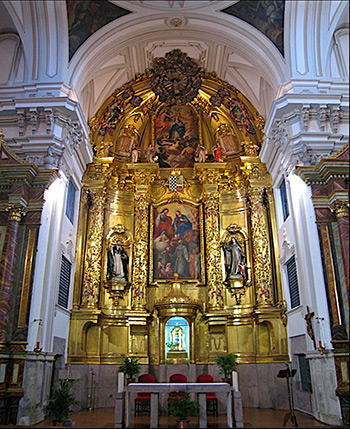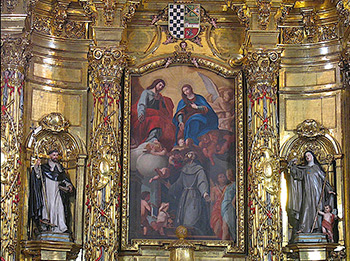Route through the 18th century altarpieces of Baztania
Main altarpiece of the Poor Clares of Arizkun: an exceptional piece.
The convent of Poor Clares of Arizkun was board of trustees of Don Juan Bautista Iturralde, Marquis of Murillo, and his wife Doña Manuela Munárriz. Both had endowed the new convent and had been demonstrating their role as promoters of the arts in other foundations and devotions of the family in Navarra, Madrid and Alcalá de Henares. With his enrichment through commerce and his relationship with the Crown, as a bailiff and lessor of royal rents, he and his wife made countless gifts and foundations that give us an idea of their piety and deep religious sense. Among the works they promoted are the Poor Clares of Arizkun, other works and donations for the same locality, the high school of San Juan Bautista de Pamplona, endowments for chapels in Madrid, gifts in cash and the wood for the main altarpiece of Santo Tomás de Dominicos de Madrid, altarpieces and images in the convent of Jesús María de Valverde in Fuencarral, in whose conference room the marquises were buried, and the collateral altarpieces and money for ornaments of the convent of the Mother of God of the Dominicans of Alcalá.
The deed for the realization of the altarpieces of the Arizkun convent with José Pérez de Eulate was signed in Pamplona on August 11, 1736. The project or traces were imposed on the Pamplona artist and we know that they had been ordered to be made, with all certainty, in Madrid, and that they arrived in Pamplona signed with the signature of Iturralde. It was, therefore, the promoter of the foundation and its endowment who chose the plan to follow in the altarpieces, in the same way that years before he had ordered the master builder Fausto Manso, who lived in Madrid, to draw the traces of the convent. Regarding the decorative motifs, it is only said repeatedly that they will be "as the traces show".
The execution period was set at one year for the main altarpiece and twenty months for the collaterals. The price would amount to 1,600 silver ducats distributed in the usual three thirds. The recognition of the set was carried out by the master of Sos del Rey Católico established in Pamplona, José Ferrer, on July 1, 1738. After carefully examining the pieces and their traces, he considered that Pérez de Eulate had fulfilled his obligation, also pointing out a series of improvements in the tabernacle, in the main columns where he had added twelve seraphs, four cards in the shell and twenty-eight modillions in the collaterals. In Ferrer's opinion, all of this was necessary and necessary for "the greater decency and ornamentation of said altarpiece and collaterals so that they would correspond with the rest of their construction".
Pérez de Eulate had the opportunity to confront an altarpiece model foreign at that time to these lands and particularly in the Pamplona workshop, in which, in general, Solomonic columns dressed with flowers were still used. It is a shell altarpiece related to the Madrid school, both for its architectural concept with monumental and clear lines, as well as for some decorative motifs. It consists of a stone pedestal, a high bench with four concave corbels, the interior ones in frontal disposition and the exterior ones at profile. All of them have lost the decoration that was arranged on their cut plates, in which the trace of the decorative foliage cards can still be seen; undoubtedly this suppression was made in the neoclassical period, when the primitive exhibitor was substituted by the current nineteenth-century templete. The concave arrangement of the corbels is reminiscent of some altarpieces from Madrid, such as the one in the parish of Nuestra Señora de la Asunción de Meco. The main body of the altarpiece is mounted on the bench, divided into three sections -the central one of greater dimensions- by columns of gigantic order with composite capitals and fluted shafts decorated with crossed palms, adventitious plaques, ribbons and hanging fabrics. On the side streets there are shallow niches with trapezoidal pedestals to support sculptures, while in the central one there is a box to house a painting with the coat of arms of the Marquises of Murillo, patrons of the convent. A large entablature of broken lines gives way to the shell with a powerful arch, which is decorated with carved cards, coats of arms of the Franciscan order supported by angels and palms and a large central core topic with clouds, cherubs and the Dove of the Holy Spirit. In the interior of the shell occupies the center a canvas and two feigned windows with their half-drawn curtains of clear scenographic values.
The gilding of all the altarpieces of the convent was immediately done by the painter of Madrid, Pablo Antonio de Castro, who agreed with the Marquis the conditions for this purpose. position .
The iconography of the set presents in the main body a canvas with the topic of the Glorification of St. Francis, and on its sides two carvings of St. Dominic of Guzman and St. Clare, of Madrid affiliation; in the attic we find the canvas of the patroness of the convent Our Lady of the Angels, with the topic of the Coronation of the Virgin between angels musicians and four sculptures of allegories of virtues on the entablatures.
This altarpiece, of courtly influence, is one of the first examples of its type in these lands, model that would triumph in the following two decades in the Basque Country, Navarre and other regions of northern Spain, always following the guidelines set by José Benito Churriguera in the altarpiece of the Calatravas in Madrid at the beginning of the 1920s. With it, José Pérez de Eulate escapes from the decorative tradition of the Pamplona workshop and confronts a brave architecture that is alien to the altarpieces that came out of the Pamplona workshops of the time.
CRUZ YABAR, M. T., "José de Hermosilla y el retablo de Irurita en Navarra", file Español de Arte, n.º 290 (2000), pp. 51-65.
FERNÁNDEZ GRACIA, R., El retablo barroco en Navarra, Pamplona, Government of Navarre, 2003.
FERNÁNDEZ GRACIA, R., "El triunfo del Academicismo en los retablos baztaneses y el project para el mayor de Villafranca (1783) en un dibujo de la Library Services Nacional", Studium, Magisterium et amicitia. Homage to professor Agustín González Enciso (ed. R. Torres Sánchez), Pamplona, Eunate, 2018, pp. 467-478.
FERNÁNDEZ GRACIA, R., "En torno a la registration de la Virgen del Rosario de Irurita, obra de Juan Domingo Olivieri, de 1749", Pieza del mes de marzo de 2023. Chair de Patrimonio y Arte Navarro.
GARCÍA GAINZA, M.ª C., "Virgen del Rosario, signed by Olivieri", file Español de Arte, n.º 235 (1986), pp. 324-329.
GARCÍA GAINZA, M.ª C., El escultor Luis Salvador Carmona, Pamplona, University of Navarra, 1990.
GARCÍA GAINZA, M.ª C., "Sobre las esculturas de Luis Salvador Carmona en Lekaroz", Cuadernos de la Chair de Patrimonio y Arte Navarro, n.º 2, Pamplona, 2008, pp. 243-255.
GARCÍA GAÍNZA, M.ª C., "Alonso Cano y José Ribera, fuentes inspiradoras en la obra de Luis Salvador Carmona: el martirio de san Bartolomé de Lekaroz", Pieza del mes de mayo de 2015. Chair de Patrimonio y arte navarro.
MARTÍN GONZÁLEZ, J. J., "Problemática del retablo bajo Carlos III", Fragmentos n.º 12-14 (1988), pp. 33-43.











